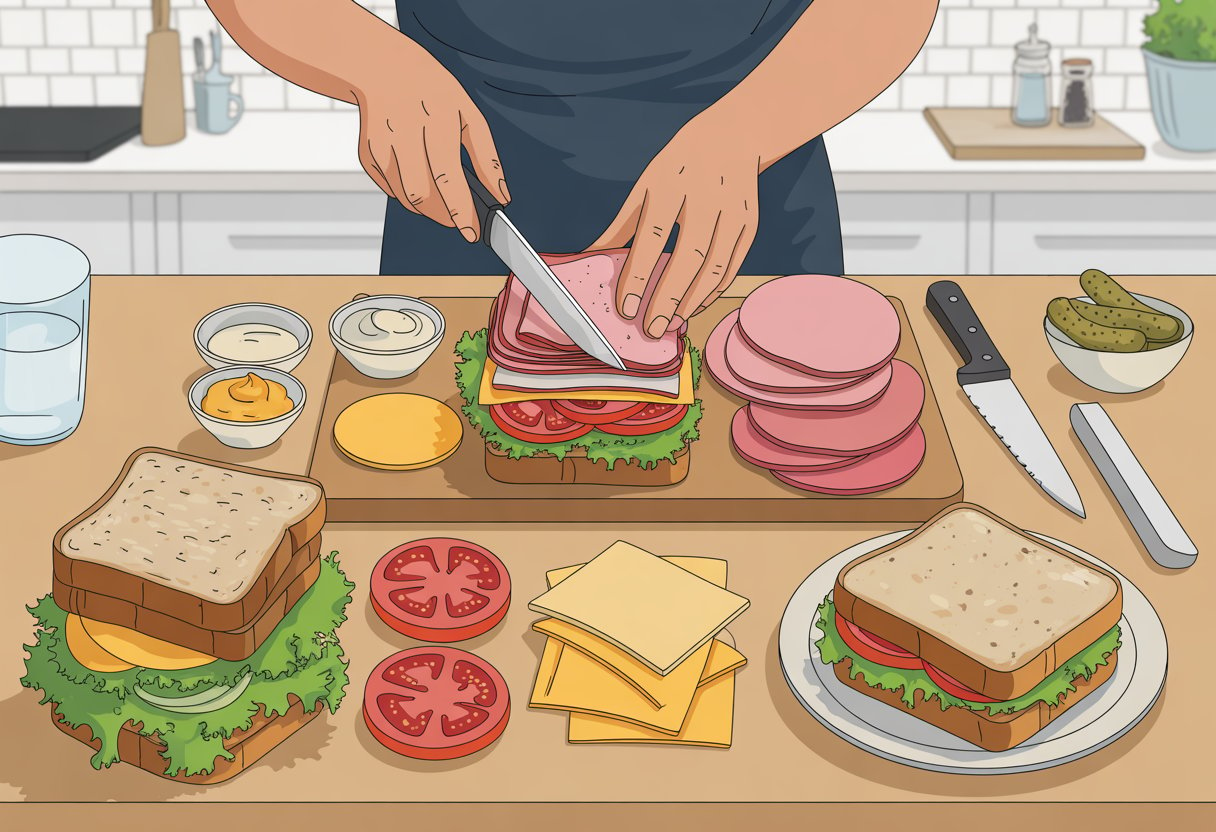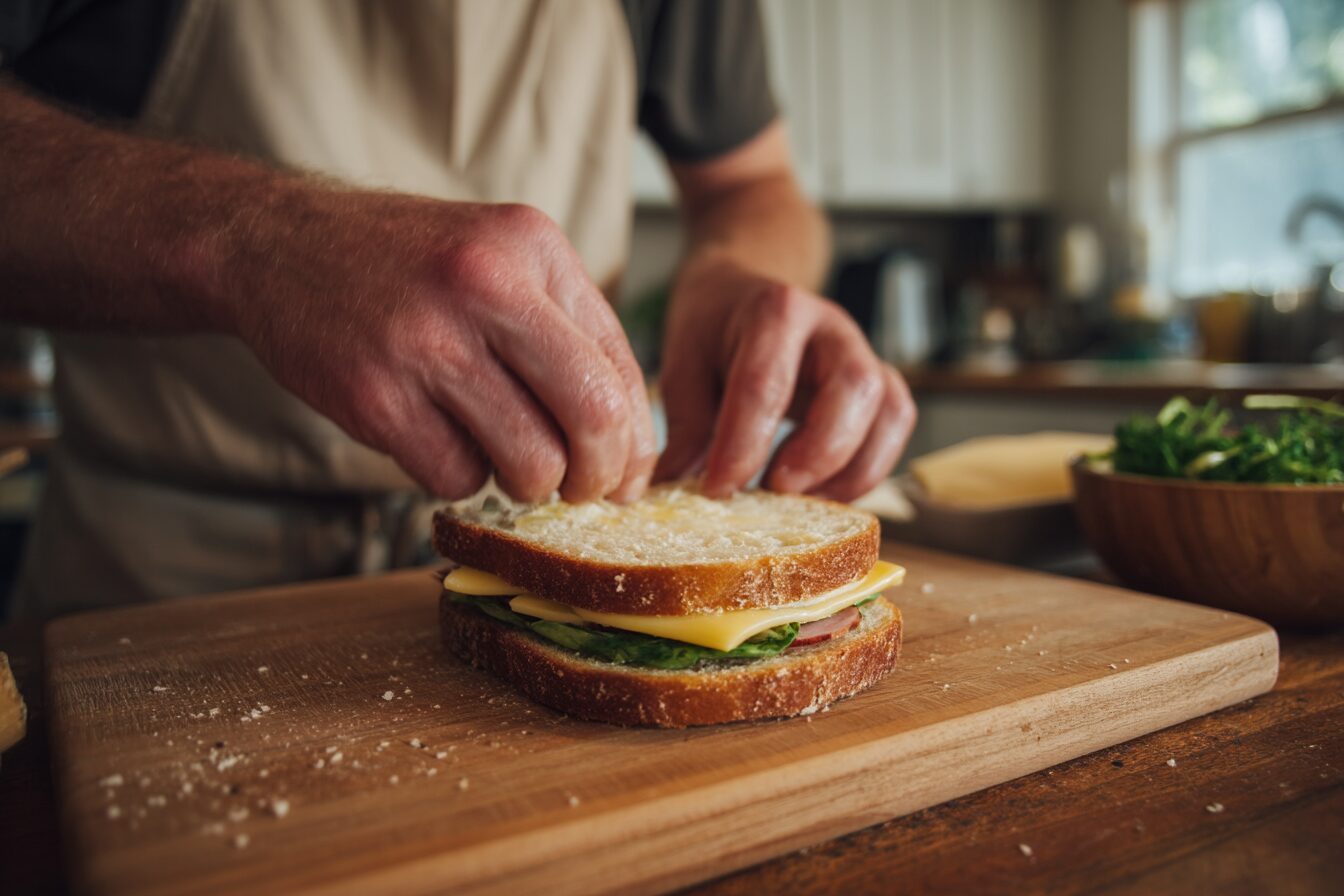When it comes to making a truly satisfying sandwich, the right methods can turn an ordinary lunch into something memorable. Using quality ingredients, proper seasoning, and thoughtful layering makes any sandwich taste more like a deli classic. These small steps—like toasting bread for crunch and seasoning each element—make a big difference in the final bite.

Many overlook techniques such as adding a touch of butter or vegetable stock to meats, or toasting them slightly, which brings out deeper flavors and textures. Swapping basic store-bought bread for freshly baked options and experimenting with spreads like mustard or flavored butters can give any sandwich a gourmet touch.
Key Takeaways
- Great sandwiches start with fresh, high-quality ingredients.
- Simple preparation methods elevate both flavor and texture.
- Small details and seasoning make a noticeable difference.
Choosing the Best Ingredients for Sandwiches
Making a standout sandwich relies on picking bread, cheese, meats, and condiments carefully. High-quality choices in each of these categories can make a noticeable difference in flavor, texture, and overall satisfaction.
Selecting Good Quality Bread
Quality bread serves as the foundation for any sandwich. Freshly baked loaves, such as sourdough, rye bread, or ciabatta, hold up well and offer great texture. Dense breads like rye provide structure, which is especially useful for stacked sandwiches with heavier fillings like pastrami or corned beef.
Sandwich breads should be chosen depending on the fillings—soft potato breads for delicate ingredients, or crusty bread for grilled options. For grilled ham and cheese sandwiches, a firm bread like sourdough creates a crisp outer layer without becoming soggy.
The bread’s flavor should complement the filling, not overwhelm it. A classic baguette pairs well with gruyère and ham, while seeded breads can add an extra layer of taste and crunch. Freshness remains the most important factor; stale bread will ruin even the best sandwich.
Picking the Right Cheeses and Meats
The combination of cheese and meat determines much of a sandwich’s character. For classic deli-style options, swiss cheese, gruyère, and mozzarella are favorites. Gruyère and swiss melt easily, creating a gooey, melty layer—perfect for grilled cheese or croque monsieur.
Ham, pastrami, and corned beef are timeless deli choices, each bringing distinct flavors. Thinly sliced meats help evenly distribute flavor and prevent an overly dense bite. Mixing meats, like turkey with ham, can provide balance and variety.
Hard cheeses are great for bold flavor, while mild mozzarella is excellent for lighter sandwiches. Ensure the cheese and meat are of good quality and freshly sliced. It’s also key to let the cheese melt for hot sandwiches—paired with crispy bread, this brings the “melty, gooey” effect many people love.
Spreads, Condiments, and Extras
Spreads and condiments tie everything together. A good sandwich can be elevated with a layer of mayonnaise, dijon mustard, or thousand island dressing. Fig jam works well with rich meats and cheeses like brie or ham, offering a touch of sweetness.
A table of popular additions:
| Condiment/Spread | Best Pairings |
|---|---|
| Mayonnaise | Turkey, chicken, coleslaw |
| Dijon Mustard | Ham, roast beef, pastrami |
| Thousand Island | Corned beef, Swiss cheese |
| Fig Jam | Ham, brie, gruyère |
Extras like pickles, sauerkraut, and coleslaw provide crunch and acidity, cutting through fatty meats or cheeses. Pickled red onions and chiles add heat and brightness. The right combination of spreads and extras enhances both the taste and eating experience, making every bite satisfying.
Top Methods to Make a Sandwich
Every great sandwich starts with high-quality bread, flavorful fillings, and the right layering technique. Whether it’s a classic favorite or a creative combination, knowing different methods ensures variety and taste in every bite.
Classic Sandwich Recipes
Classic recipes like the club sandwich, BLT sandwich, and peanut butter and jelly sandwich have become staples because of their straightforward method and comforting flavors. For a classic club, layering is key: start with toasted bread, alternate between turkey or chicken, crispy bacon, lettuce, and tomato, and finish with a light mayo spread. Secure each section with toothpicks and slice into neat triangles for easy sharing.
A BLT sandwich highlights crispy bacon, fresh lettuce, and ripe tomato on slices of toasted bread, with a thin layer of mayo that adds creaminess without overpowering the main ingredients. Peanut butter and jelly sandwiches are as simple as they sound. Use soft sandwich bread, spread peanut butter evenly on one slice and jelly on the other, and press together.
Tuna salad sandwiches, another comfort food favorite, offer a creamy filling of tuna, mayonnaise, celery, and sometimes chopped pickles or onion. Scrambled eggs can be added for protein-rich breakfast sandwiches, often paired with sliced bacon or cheese.
Grilled and Hot Sandwich Techniques
Hot sandwiches like grilled cheese, Reuben, and fried chicken sandwiches rely on heat, which transforms both texture and flavor. For grilled cheese, use buttered bread and stack with sliced cheese such as cheddar or American. Grill in a pan until the bread is golden and the cheese is melted for a crispy outside and gooey center.
The Reuben sandwich starts with rye bread, layered with corned beef, Swiss cheese, sauerkraut, and Russian dressing, then cooked on a skillet until the cheese melts and the bread is toasted. Hot sandwiches benefit from using fresh, sturdy bread, as it crisps well and holds fillings without getting soggy.
Fried chicken sandwiches use breaded, fried chicken breasts, usually served with pickles and a mayo or spicy sauce on a toasted bun. Heated sandwiches are best enjoyed fresh, as their crispy and melted textures make them stand out.
Creative Twists and Special Combinations
Creative methods allow room for experimenting with sauces, vegetables, and unexpected fillings. For a fun picnic idea, try adding layers of roasted vegetables, different cheeses, or specialty breads like focaccia or ciabatta. Use a table like this for ideas:
| Ingredient | Possible Combinations |
|---|---|
| Cheese | Gouda, cheddar, brie |
| Sauces/Spreads | Pesto, aioli, hummus |
| Proteins | Roasted turkey, eggs, tofu |
| Veggies | Arugula, grilled peppers |
Mixing sweet and savory, such as adding apple slices to a ham and cheese sandwich, creates new flavors. Scrambled eggs and bacon can be paired with avocado for a hearty breakfast option. Multigrain or seeded breads add texture, while toasting can enhance flavor.
For special combinations, think beyond typical fillings. Tuna salad with sliced cucumber or a grilled cheese with caramelized onions and tomato can offer gourmet flair. Small adjustments in assembly, like layering wet ingredients between dry, help keep sandwiches crisp and enjoyable.
Frequently Asked Questions
Making a delicious sandwich at home is easy with quality ingredients, thoughtful preparation, and a few smart techniques. Anyone can boost their sandwich skills with attention to layering, flavor pairing, and detail.
What are the essential steps to crafting the perfect sandwich?
A great sandwich starts by choosing the right bread and fresh ingredients. Each layer, from protein to vegetables to cheese, should be assembled for flavor balance and texture. Spreads or condiments help add moisture and tie everything together.
Could you guide me through a simple sandwich-making process?
First, lay out all ingredients and tools for easy access. Spread any sauces or butter on the bread to prevent sogginess. Layer protein, cheese, and vegetables, then close with the top slice. Slice if desired, and serve immediately.
What ingredients do I need to start making a tasty sandwich at home?
Basic sandwich needs include bread (such as whole grain, sourdough, or rolls), a protein (like deli meat, cooked chicken, or tofu), and cheese. Fresh vegetables, such as lettuce, tomato, cucumber, and sauces or spreads add flavor and texture.
Could you share some pro tips for elevating my sandwich-making skills?
Use fresh, high-quality ingredients to improve taste and texture. Toasting the bread adds crunch and aroma. Layer crunchy and moist ingredients carefully to maintain structure. Don’t forget to season lightly with salt and pepper.
What are the quintessential elements for a well-balanced sandwich?
Balance comes from mixing different textures—crisp lettuce, juicy tomato, and creamy cheese. Flavors should complement rather than compete; salty, savory, tangy, and sometimes sweet notes work well together. The right ratio of fillings to bread keeps each bite enjoyable.
How can I follow a sandwich recipe to ensure a delicious outcome?
Assemble all measured ingredients before starting. Follow recipe steps in order, paying attention to suggested layering and spreading techniques. Taste as you go if possible, and adjust seasonings to preference for the best result.














